Should Ecuador's left work with the right against Rafael Correa?
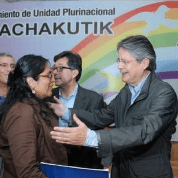
Banker and opposition leader Guillermo Lasso (second from right) meets with leaders from the Pachakutik political party in their offices in April 2015.
For more on Ecuador, click HERE.
By Pablo Vivanco
August 20, 2015 – Originally published by TeleSUR English, posted at Links International Journal of Socialist Renewal – For a relatively small nation, in terms of size, population and economics, Ecuador has been a major player in contemporary Latin American politics, particularly on the left.
The experience of toppled governments by popular uprisings, led by Indigenous organisations with radical left-oriented politics, has contributed to a regional shift that ushered in the Bolivarian Revolution in Venezuela and later the election of Evo Morales’ Movement Toward Socialism in Bolivia.
In Ecuador itself, popular movements culminated in the election of Lucio Gutierrez (who subsequently betrayed his leftist mandate only to be overthrown himself) and in 2006, to the election of Rafael Correa, a progressive economist who gained local fame during his brief tenure as minister of finance. In addition to chastising former US President George W. Bush, Correa became popular with Ecuadorans but angered the International Monetary Fund and World Bank by increasing health and education budgets, while decreasing interest rates on government bonds.
When the World Bank cancelled Ecuador’s loan and Correa was forced to resign; he did so while polling as the most trusted politician in the country.
Eight years into Correa’s government – which his supporters calls the Citizen’s Revolution – he retains high popularity, and the country has one of the most stable economies in the region. Moreover, Ecuador has become an arguably more just and democratic country, with 1.1 million people lifted out of poverty, election participation exceeding 80 per cent and countless means of citizen participation that previously did not exist.
Not on the right path?
Yet, there is an opposition movement that is claiming that the country is not on the right – or left – path.
In August, on the heels of protest organised by right-wing leaders against proposed increases to inheritance and capital gains taxes, leaders from movements of some of the country’s historically leftist movements – including the once powerful Conaie Indigenous movement – called for national actions against Correa.
While the August 13 date for the People’s Strike and Indigenous Uprising has come and gone, actions continue, with leaders of opposition organisations refusing calls for dialogue and promising an "escalation", including a general strike.
From outside, Ecuador is now a paradox where organisations callings themselves leftist are mobilising against a government calling itself socialist. A closer look reveals a trail of political schisms and realignments – especially increasing collaboration between right and left movements and parties against Correa – in what amounts to a struggle for power over the country’s highest office.
The rifts: power and policy struggles
Conaie, along with the electoral wing and mass fronts for the Marxist-Leninist Communist Party of Ecuador (PCMLE), were significant actors in the street mobilisations that brought down former president Jamil Mahuad (2000) and later Gutierrez (2005).
As many have pointed out, they were also part of the broad left front that brought Correa to power in 2006. With Correa’s PAIS (Proud and Sovereign Homeland) Alliance freshly formed, he sought the support of Conaie, its electoral arm Pachakutik, as well as the PCMLE electoral wing the Popular Democratic Movement (MPD) in the campaign.
The first major rift occurred when Correa approached Pachakutik, offering to put their candidate for the position of vice-president. According to journalist Juan Meriguet Martinez, “Correa held out to the 11th hour hoping [Pachakutik] would accept the offer.” Pachakutik instead insisted on its leader, Luis Macas, running for president and Correa running as vice-president.
Both Pachakutik and the MPD ran their own candidates, but ultimately supported Correa in the second round of voting.
The major break between the groups, however, occurred in 2009, when Correa began pushing for reform in the country’s notoriously poor education system. Fresh from a first round victory that saw Correa win the April 2009 election with 52 per cent – a remarkable achievement given no president had won re-election since 1875 – the government introduced reforms to address quality of public education.
The move – especially measures that would remove unqualified teachers and make institutions improve accounting for public funds – led to protests from the UNE teachers union and FEUE student group, both fronts of the MPD/PCMLE. Critics of the reforms maintain that the move betrayed Correa’s desire to reorient the country’s education system towards “the service of capital” – supporters argued that the system was full of unqualified teachers and that funds were diverted to the MPD through the influence that UNE wielded in the institutions.
“All of my friends who were MPD were given tenure, even if they hadn’t graduated”, said Rocio Laiquez, a retired teacher who was forced to leave for Spain to find work. “I was a professional, but they did not give me a stable job. I only worked as a ‘substitute’ earning half (of regular pay).”
The reform passed and proved popular, but both Pachakutik and the MPD, commonly referred to in Ecuador as los chinos due to the former Maoist orientation of their parent party the PCMLE, radicalised in their opposition to Correa.
On September 30, 2010, police officers and some military undertook actions to protest changes in their remuneration – which actually increased their pay. The events turned violent, with police attacking Correa after the leader showed up to a barracks in Quito, while other officers blocked highways and airports, even occupying the national assembly. MPD leader Luis Villacis was among those officers outside of the assembly, telling the rebel police that his Marxist-Leninist outfit supported them, and that “they were also part of the people”.
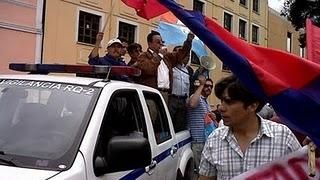
MPD Leader Luis Villacis urging support for police occupying the National Assembly on September 30, 2010.
By the time Correa was rescued from the police hospital that he had been forced to hide in, eight people were dead and 274 people wounded.
The PCMLE/MPD and Pachakutik, who also released a statement in support of the police, refused to call the events a coup. Former Pachakutik lawmaker Clever Jimenez went so far as to say Correa orchestrated the events, and accused the leader of "genocide".
Deals, duplicity and dialogue
The events of September 30, 2010, were undoubtedly a turning point in the relationship between "lefts" in Ecuador, and these groups, namely Pachakutik and the MPD/PCMLE have increasingly collaborated with right-wing sectors.
Just before the 2013 presidential election, banker and former finance minister Guillermo Lasso surprised many by introducing Aiki Tituaña, a leader within Conaie and Pachakutik, as his running mate.
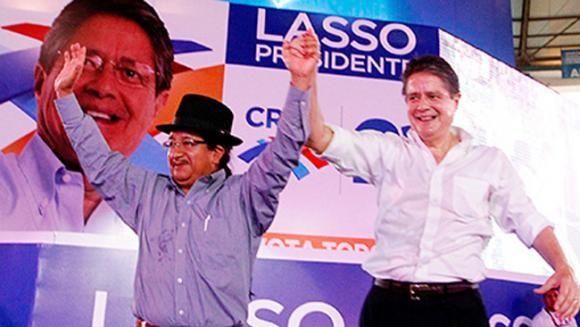
Guillermo Lasso (right) announces Aiki Tituaña (left) as his running mate. Photo: Andes.
Although both indigenous organisations condemned the pact, this would not be the only setback faced during the elections. Conaie, Pachakutik, MPD and others ran their own ticket with former constituent assembly head Alberto Acosta heading a coalition called the Plurinational Unity of the Lefts. Despite this "unity", the overall percentage obtained by the parties plummeted to 3.26 per cent, and their nine seats in the National Assembly were reduced to five.
Following the defeat – in which Correa upped his votes and where his PAIS Alliance won 74 per cent of seats in the National Assembly – the anti-government leftist groups maintained their activity, mainly organising against government proposals and projects.
The groups were active among those protesting Correa’s announcement that 1 per cent of oil from the YASUNI area would be exploited, after Ecuador’s innovative campaign to obtain funds to keep the resource in the ground failed.
Indeed, they were also involved in protests against water and labour legislation, although others critical of the laws were looking for reforms to the proposals, rather than a scrapping of them. Proponents of the laws, including numerous social movements, point to the progressive elements in each – enshrining water as a public right that cannot be privatised, and integrating millions of workers, including domestic and informal workers, in the country’s social security system.
Nonetheless, these groups have also begun to adopt the populist positions of Ecuador’s right wing, and their collusion with their leaders and protests have become more evident.
At a protest against taxes on luxury imports in March, Carlos Perez of the Ecuarunari group told Reuters, “We are about to become a dictatorship. If there is indefinite re-election we will be the same as Venezuela, the same as Iraq, the same as Italy, as it was in Germany.” Perez also spoke against the tax proposal.
Two months later, Correa announced another tax proposal – this time directed at capital gains and inheritance taxes. Although the government emphasised that barely 2 per cent of the population would be impacted by these taxes, the right wing astutely seized the issue and began to organise protests.
Seeing that the protests were gathering steam and with their sights set on Correa (the common slogan in the marches and social media calls was Fuera Correa fuera, or "Out Correa out"), the groups began to join the demonstrations and adopt anti-tax calls. The MPD’s Villacis, Pachakutik legislator Lourdes Tiban and Andres Paez of Lasso’s CREO party – who was also the lawyer for Chevron – began holding June meetings, while the groups convened their own supporters for the right-wing rallies.
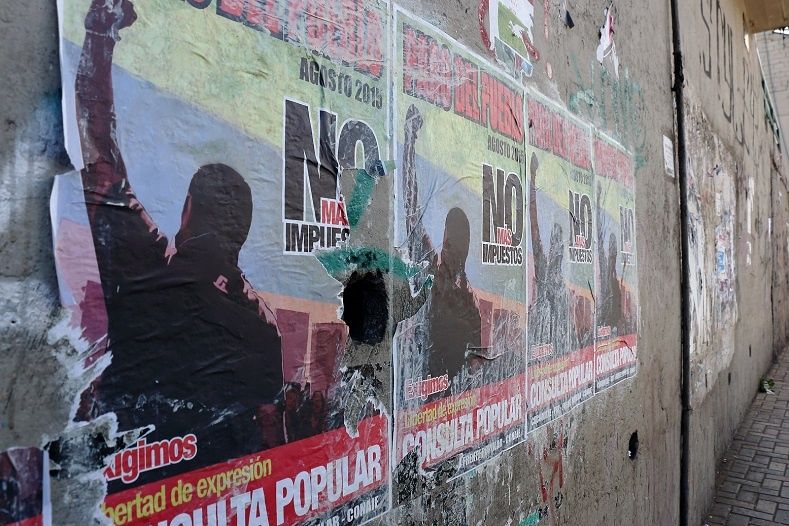
Poster from Conaie and other opposition groups: “People’s Strike – No More Taxes” Photo: TeleSur.
Following protests against the taxes in Quito, Guayaquil and other places, Conaie set a date for an "Indigenous uprising" while opposition-aligned trade unions announced a National "work stoppage".
The groups put out a laundry list of demands, including:
● scrapping proposed constitutional amendments, especially the elimination of presidential term limits;
● shelving the inheritance and capital gains tax proposals;
● repealing the education reform;
● shelving the water and labour laws;
● cancelling a trade agreement with the EU; and
● ending a program designed to mass produce induction ovens, among others.
The action was an unprecedented display of unity between right-wing sectors – including support from opposition legislator Paez, Guillermo Lasso, banana magnate and former presidential candidate Alvaro Noboa, and Guayaquil mayor Jaime Nebot – and the "left" opposition groups.
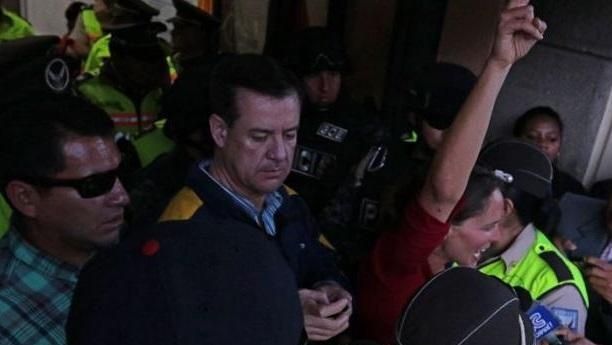
Opposition lawmaker and anti-tax protest leader Andres Paez leaves the courtroom with Manuela Picq, a foreign activist arrested amid violent protests on Aug. 13, 2015. Photo: Andes.
Despite this "broad" support, the actions – which turned violent – were not able to attract the expected number of people to the streets, let alone to abandon their workplaces. "The Ecuadorean people turned their backs on this strike”, secretary-general of the PAIS Alliance Doris Soliz told the press. “Workers, business owners, people in the transportation sector, economic sectors did not go on strike."
While no official figure for the number of protesters was released, there is a general sentiment that the popular uptake was a far cry from the days when Conaie and its allies successfully toppled governments.
A major difference between the actions and those of Conaie’s heyday – in addition to the operational alliance between these groups and right-wing sectors – was the segment of the left that supports Correa’s government, as well as those who support dialogue with it.
In response to the backlash against the tax proposals, Correa called for a "national dialogue" on tackling the country’s persistent inequality and poverty. While Conaie and those calling for protests have refused to meet with officials, many groups, including labour unions, indigenous groups and social movements, have opted for talks with the government.
"We have come here today just to put forward the issues that led some people to take to the streets”, said Romelio Gualan, president of the Eloy Alfaro National Campesino Coordination, as he left one such dialogue with government officials. “We have seen the opportunity for dialogue, to discuss the themes that are lagging behind in the countryside. We put this forward to the president of the National Assembly along with a timetable to see how we can make advances.”
On the same day that Ecuarunari’s Perez called for a military and police rebellion against Correa’s government, the head of the FUT trade union warned his members would go on a general strike if the National Assembly does not abandon its discussions around the constitutional amendments. The long list of demands has now boiled down to one clear objective – stop the possibility of Correa's reelection in 2017.
Meanwhile, most Ecuadorans are going about their lives, more concerned about the traffic jams caused by the relatively small but persistent protests, than the issues that opposition groups of the left and right have been pressing.
The rallies continue, as do government efforts to assuage policy concerns through talks. Nonetheless, there is an air of tension given the increasing violence of the protests and the lingering memory of the 2010 coup.